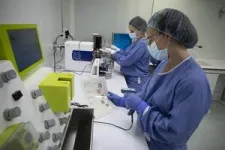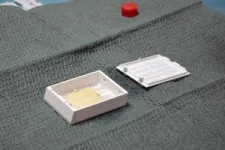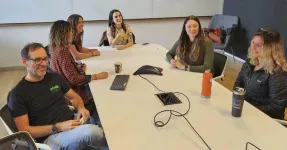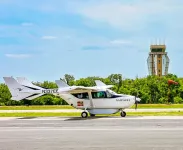(Press-News.org) The results of a pioneering study support the safety of the bioimplants called PeriCord, made from stem cells of the umbilical cord and pericardium from a tissue donor, which aid in the regeneration and revascularisation of the affected area.
The study has monitored 7 interventions of this pioneering tissue engineering surgery over three years, noting excellent biocompatibility and no rejection in patients.
The therapy has been developed by the research group ICREC (Heart Failure and Cardiac Regeneration) at Germans Trias i Pujol Research Institute (IGTP) and Banc de Sang i Teixits (BST).
PeriCord has anti-inflammatory properties and opens the door to creating other drugs for conditions beyond the heart.
The promising results obtained in a clinical trial with a pioneering advanced therapy drug named PeriCord, which aims to repair the heart of patients who have suffered a heart attack, confirm the feasibility of new therapies based on the application of stem cells and tissue engineering to promote the regeneration of damaged tissues.
This new medicine, derived from umbilical cord and pericardium stem cells from tissue donors, is a world-first tissue engineering product (a type of advanced therapy combining cells and tissues optimised in the laboratory). The drug is applied in patients undergoing coronary bypass, utilising the procedure to repair the scar in the heart area affected by the infarction, which has lost the ability to beat when blood flow stopped.
The first intervention of this new therapy was almost 4 years ago, resulting from a collaboration between the ICREC Group (Heart Failure and Cardiac Regeneration) at Germans Trias i Pujol Research Institute (IGTP) and Banc de Sang i Teixits (BST). Following its success, a study was initiated to demonstrate its clinical safety. The study included 12 coronary bypass candidates, 7 treated with bioimplants and 5 without, to compare the outcomes.
Dr Antoni Bayés, ICREC researcher and first author of the article: "This pioneering human clinical trial comes after many years of research in tissue engineering, representing a very innovative and hopeful treatment for patients with a heart scar resulting from a heart attack", referring to PeriCord.
While the current study aimed to demonstrate the safety of this new drug in the context of myocardial infarction, its positive outcomes have shown that PeriCord possesses other exceptional properties. It has proven to be a medicine with excellent biocompatibility, drastically minimising the risk of rejection and ensuring perfect tolerance by the body. Additionally, it has anti-inflammatory properties, paving the way for broader applications in pathologies involving inflammation. "Its potential could be much wider; we believe it can be a valuable tool for modulating inflammatory processes", explains Dr Sergi Querol, head of the Cellular and Advanced Therapies Service at BST.
Severe but stable patients
The patients included in the therapy are individuals who have suffered a heart attack and have reduced quality and life expectancy. The bypass ensures blood circulation in the area, and the bioimplant goes a step further to stimulate the scar, initiating cellular mechanisms involved in tissue repair.
"Voluntarily provided substances of human origin are used, both in terms of multi-tissue donor pericardial tissue and mesenchymal stem cells from umbilical cord donors at the birth of a baby", explains Querol. It is very gratifying to think that "thanks to this and the donors, we provide a new therapeutic tool that can improve a patient's quality of life", he adds.
PeriCord consists of a membrane that comes from the pericardium of a tissue donor, which BST has decellularised and lyophilised. It has then been recellularised with these umbilical cord stem cells.
Once in the operating theatre, surgeons attach the laboratory-generated bioimplant to the affected area of the patient's heart. After a year, the implanted tissue adheres and adapts perfectly to the structure of the heart, covering the scar left by the heart attack.
END
First cardiac bioimplants for the treatment of patients with myocardial infarction using umbilical cord stem cells
2024-04-05
ELSE PRESS RELEASES FROM THIS DATE:
Drug shortages prior to and during the COVID-19 pandemic
2024-04-05
About The Study: Supply chain issues associated with drug shortages increased at the beginning of the COVID-19 pandemic according to the results of this national cross-sectional study. Ongoing policy work is needed to protect U.S. drug supplies from future shocks and to prioritize clinically valuable drugs at greatest shortage risk.
Authors: Katie J. Suda, Pharm.D., M.S., of the University of Pittsburgh School of Medicine, is the corresponding author.
To access the embargoed study: Visit our For ...
Radiation before mastectomy cuts time delays for reconstructive surgery in breast cancer patients
2024-04-05
Researchers at The University of Texas MD Anderson Cancer Center showed that altering the sequence of breast cancer treatment to administer radiation before mastectomy allowed for concurrent breast reconstruction surgery, which reduced the number of operations required, minimized treatment delays and improved patient satisfaction.
The Phase II trial results, published today in JAMA Network Open, evaluated 49 patients who received radiation therapy followed by mastectomy with immediate breast reconstruction. There were no complete flap ...
A deep dive into the genetics of alcohol consumption
2024-04-05
A research group centered at the University of California San Diego School of Medicine has drilled deep into a dataset of over 3 million individuals compiled by the direct-to-consumer genetics company 23andMe, Inc., and found intriguing connections between genetic factors influencing alcohol consumption and their relationship with other disorders.
The study was recently published in the Lancet eBioMedicine.
Sandra Sanchez-Roige, Ph.D., corresponding author and associate professor at UC San Diego School of Medicine Department of Psychiatry, explained that the study used genetic data to broadly classify individuals as being European, Latin American ...
CHEOPS detects a ‘‘rainbow’’ on an exoplanet
2024-04-05
The CHEOPS space telescope, whose scientific operations centre is based at the University of Geneva (UNIGE), is providing new information on the mysterious exoplanet WASP-76b. This ultra-hot giant is characterised by an asymmetry between the amount of light observed on its eastern terminator - the fictitious line that separates its night side from its day side - and that observed on its western terminator. This peculiarity is thought to be due to a ‘‘glory’’, a luminous phenomenon similar to a rainbow, which occurs if the light from the star - the ‘‘sun’’ around which the ...
UTSA joins consortium to create sustainable aviation hub in San Antonio
2024-04-05
(SAN ANTONIO, TEXAS) — UTSA has signed a memorandum of understanding (MOU) with the U.S. Department of Energy Advanced Research Projects Agency – Energy (ARPA-E), the City of San Antonio, and CPS Energy to develop and promote energy technologies that could potentially decarbonize the aviation sector. The ambitious project will pursue a range of research and development objectives, including sustainable aviation technologies, battery technologies and battery storage solutions, enhanced electric vehicle charging technologies and power-related technologies. The MOU will position San Antonio as an innovation center for these new energy solutions, accelerating their development ...
Kerr-enhanced optical spring for next-generation gravitational wave detectors
2024-04-05
The detection of gravitational waves stands as one of the most significant achievements in modern physics. In 2017, gravitational waves from the merger of a binary neutron star were detected for the first time which uncovered crucial information about our universe, from the origin of short gamma-ray bursts to the formation of heavy elements. However, detecting gravitational waves emerging from post-merger remnants has remained elusive due to their frequency range lying outside the range of modern gravitational wave detectors (GWDs). ...
Magnetic resonance imaging in prostate cancer screening
2024-04-05
About The Study: The results of this systematic review and meta-analysis suggest that integrating magnetic resonance imaging (MRI) in prostate cancer screening pathways is associated with a reduced number of unnecessary biopsies and overdiagnosis of insignificant prostate cancer while maintaining clinically significant prostate cancer detection as compared with prostate-specific antigen (PSA)-only screening.
Authors: Shahrokh F. Shariat, M.D., D.Dr.(hc), of Medical University Vienna in Vienna, is the corresponding author.
To access the embargoed study: Visit our For The Media website at this link https://media.jamanetwork.com/
(doi:10.1001/jamaoncol.2024.0734)
Editor’s ...
The sense of smell is influenced by cues from other senses
2024-04-05
The sense of smell is highly influenced by the cues from other senses, while the sense of sight and hearing are affected to a much lesser extent, shows a new study in Journal of Neuroscience.
A popular theory of the brain holds that its main function is to predict what will happen next, so it reacts mostly to unexpected events. Most research on this topic, called predictive coding, has only focused on what we see, but no one knows if the different senses, such as smell, work in the same way.
To figure out more about how smell relates to how we ...
RNA that doesn’t age
2024-04-05
Certain RNA molecules in the nerve cells in the brain last a life time without being renewed. Neuroscientists from Friedrich-Alexander-Universität Erlangen-Nürnberg (FAU) have now demonstrated that this is the case together with researchers from Germany, Austria and the USA. RNAs are generally short-lived molecules that are constantly reconstructed to adjust to environmental conditions. With their findings that have now been published in the journal Science, the research group hopes to decipher the complex aging process of the brain and gain a better understanding of related degenerative diseases.
Most cells in the human ...
Study finds many younger people from high income neighborhoods jumped the eligibility queue for COVID-19 vaccines in NYC
2024-04-05
Despite vaccine shortages, many younger people in New York City accessed vaccines ahead of schedule, particularly in high-income areas, according to new research at Columbia University Mailman School of Public Health. Low-income areas with high proportions of older people demonstrated lower coverage rates than wealthier areas in the first three months of vaccine rollout, and higher mortality over the year. The findings are published in the Journal of Urban Health.
“A vaccine program that prioritized those at greatest risk of COVID-19-associated morbidity and mortality would have prevented more deaths than the strategy that was implemented,” said Nina Schwalbe, adjunct ...






